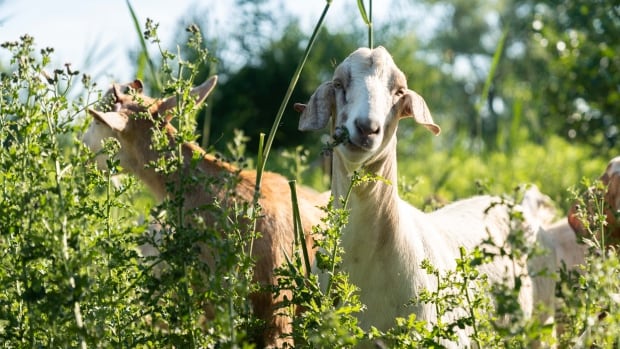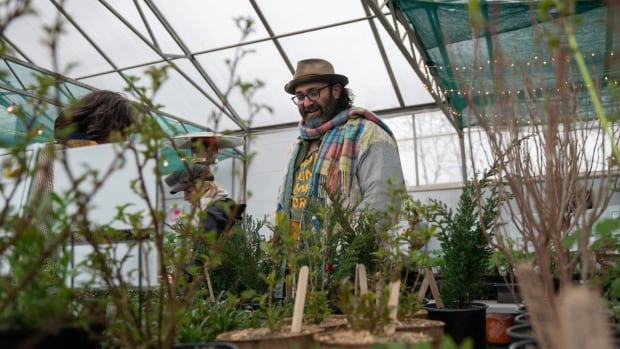When an invasive species threatened a recently restored wetland in Fort Erie, Ont., Niagara Parks put a team together to mow them down.
Or a herd, rather.
To stop the spread of phragmites, an invasive reed that’s run rampant over an area called Gonder’s Flats, environmental planning technician Victoria Kalenuik asked a local farmer to lend “as many goats as possible” for a one-week pilot project.
She sent 40 of her best and they’ve been hard at work.
“Every morning they’re excited to get out and chew down the phragmites,” Kalenuik said. “I’ve been there every morning making sure that they’re ready to go.”
Gonder’s Flats is a natural area along the Niagara Parkway, adjacent to the Niagara River. Niagara Parks has been restoring the area since 2014, but as asphalt was removed and trails were upgraded, phragmites moved in. They’re an invasive reed that can grow five metres high, with roots that release biochemicals that impede the growth of other plants.

“It’s a huge problem,” Kalenuik said. “If we don’t get control of this, it’s actually going to take over our recently restored wetland.”
Not if the goats can help it.
How Niagara Parks got the goods on goats
Every day this past week, the Green Grazers, as goats have been dubbed, have been on a phragmite feeding frenzy. The success of the one-week pilot project could turn into a long-term, sustainable solution to Niagara Parks’ phragmite problem.
Kalenuik said Niagara Parks got the idea from Ontario Power Generation, which she said used goats to eliminate phragmites on some of its properties.
According to an OPG article published on its website in July 2023, hundreds of sheep helped control vegetation and weeds at its Nanticoke Solar facility, which began operating in 2019 at the site of one of the province’s last coal-fired power plants.
OPG has said using the sheep was part of an innovative and environmentally friendly effort to keep overgrowth in check across the 107-hectare section of the facility along Lake Erie in Haldimand County.

Kalenuik said that for Niagara’s efforts to stop the spread of phragmites, other solutions were also considered before goats got involved.
Gonder’s Flats is a wetland area, so tractors couldn’t mow down the reeds without getting stuck or mucking up the terrain, she said. As well, pesticides would be too harmful to the ecosystem.
Goats, however, are nimble in the mud and all natural. Most importantly, she said, they’re ravenous.
“They eat all the phragmites.”

They’re also environmentally friendly.
“They also fertilize, obviously,” Kalenuik said.
But any phragmite seeds are “neutralized” in a goat’s digestive system, she said, so they don’t just spread the problem around.
Elsewhere in Ontario, including nearby Hamilton, scientists and environmentalists are using caterpillars to eat phragmites.
WATCH | Learn another way animals are helping humans fight an invasive plant
To control one of the region’s worst invasive plants, scientists are releasing special caterpillars into wetlands around Ontario. The caterpillars eat phragmites, a reed which outcompetes and replaces invasive plants. At a release site in Binbrook, Ont., researcher Ian Jones explains the work and shares how it’s going.
“Here in Ontario and out east, phragmites probably represents the biggest threat from an invasive plant, mostly because it is so well established,” Ducks Unlimited Canada’s Ontario invasive species lead Matt Bolding previously told CBC Hamilton.
According to Ontario’s Invasive Species Centre, invasive phragmites — which is regulated under the province’s Invasive Species Act — is a poor source of habitat and food for native wildlife, can cause lower water levels, and affect swimming, boating and fishing.
At Gonder’s Flats, Parks workers set up an electric fence to contain the goats and the farmer herds them to phragmite pockets, Kalenuik said. The goats take it from there.
“They’ve been going to town on this.”
She said she’s glad tractors can’t access the land.
“Typically in the past we just mow everything down. It’s not as fun obviously.”








